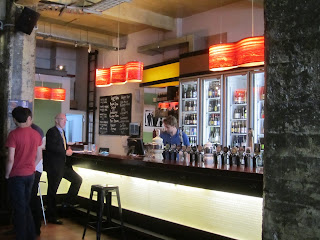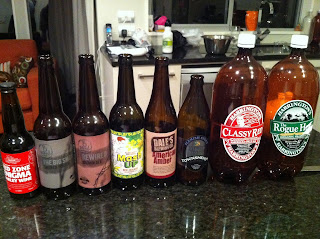If Nelson is the center of craft beer production in New Zealand, Wellington is probably the center of craft beer consumption. There are some big similarities to Vancouver - including many hipsters, and enthusiastic coffee and craft beer consumers.
This cafe and craft beer culture is deserved and long-earned. The Wellington Museum of City and Sea even displays an antique beer-drinking manual from the area...
Teetotallers nearly instituted prohibition in New Zealand - 47% voted in favour at one point in the past. And for years pubs had to close at 6pm. Which meant that working men who all got off work at 5pm had less than one hour to do their night's worth of drinking, with the obvious result of massive binge drinking. It was a happy day when pub hours were extended.
Fortunately, Wellington now has more lenient liquor laws and some great craft beer drinking opportunities.
Hashigo Zake
If you want to drink craft beer in Wellington, this is the place to come, period. A cool subterranean bar unabashedly dedicated to craft beer. The focus is on New Zealand beers, but with a good dose of various international beers, particularly in bottles.
The bright red off-street entrance announces the Asian look-and-feel.
The staff was helpful and knowledgeable, and able to provide clear suggestions and descriptions without dumbing down the information provided. Bravo. I immediately felt comfortable and informed.
Asian decor abounds. And a video monitor of tap offerings is a nice splash of high-tech.
Mike's Taranaki Hefeweizen beside Townshend Aotearoa Pale Ale. Purchasing a half-pint gets you a decent-shaped goblet, but many full pints get a more utilitarian shaker-type glass, like most venues in New Zealand. Sigh.
This is a chill venue to contemplate a complex craft beer solo, or to engage in animated discussions with several good friends. Make it your first stop - you'll probably want to return for more before you leave town.
Malthouse
The Malthouse is only a couple of years old, and is situated on a high pedestrian traffic area of downtown. As such, it has more of an after-work pop-in-to-the-local-for-a-pint feel than Hashigo Zake's more loungey, sophisticated vibe. Though its prices are just as high - if not higher - than Hashigo Zake.
Unfortunately, there's a smoker-friendly porch area right in front of the pub, whose doors are always open in summertime. So hopefully you enjoy smelling/tasting cigarette smoke in your beer, or the great-looking pizzas Malthouse serves.
The Malthouse has some great beer on tap, and a nice bottle selection. But it's a bit too busy after work to get more than a few words of advice on what to drink from the heavily occupied bartenders.
A brief break in the crowd at the bar - time to order some beer, quick!
Oh, and the crowd is back. Nice problem to have at a pub!
Full glasses are served in the ubiquitous and terrible shaker pint glass. Half glasses are served in... half-size versions of the shaker pint! Double sigh. Please, craft beer bars, serve your beer in
any other type of glass, so we have a hope of smelling/tasting it. A different glass would also leave some room for head to improve the drinking experience, instead of brimming under-sized glasses like this.
I don't want to be too down on the Malthouse - their beer selection is great. But they need a couple of tweaks before they can compete with Hashigo Zake for pure beer drinking pleasure.
Tap Haus
I didn't have a chance to sample anything at the Tap Haus, a beer restaurant that loudly proclaims its pedigree. But the specials on the sandwich board didn't look promising: Corona, Carlsberg and vodka + Red Bull. Not disappointed to give them a pass.
Garage Project
What's with this abandoned gas station?
Sweet - it's the small-volume and highly-respected
Garage Project brewery. Not quite so small as when they started out with only a little Sabco-style pilot system, but still pretty boutique.
Some new & bigger brewing equipment, and some barrels - nice.
Garage Project is not presently set up for tours or tastings. But the gang was hard at work both brewing and putting together their tasting and growler-filling room, which was still about 2-3 weeks from completion. They were nice enough to say a friendly hello to a Canadian home brewer, and sold me a T-shirt featuring the logo of their wicked Double Day Of The Dead beer I had sampled previously.
Definitely one of the coolest beer T-shirts I've come across. Be sure to watch out for these guys - they started out nano-style, have garnered great respect in New Zealand, and can never keep up with demand.
Fork & Brewer
Fork and Brewer bills itself as a craft beer and food pairing restaurant. Its menu offers beer pairing suggestions (not uncommon at pubs these days), and beer is used as an ingredient in many dishes.
The view at the top of the entrance stairway is of working brewing vessels - not just for show. Fork & Brewer makes several styles of its own beer, in addition to offering many others on tap. And the brewer is often around if you have questions or want to thank him - he's hard to miss in his big hair and beard and old school metal T-shirt.
These are both half-glasses of beer. Inexplicably, one is served in a terrible half-size shaker pint, and the other comes in a huge and decent goblet. Odd.
I have to admit, I was skeptical of Fork & Brewer - the interior said "mostly-empty high-volume bar" rather than restaurant, and I was starting to think they might be all talk and no action. But their beer was fine if not mind-blowing. The Thai beef salad was very good, and the pairing with their pilsener - definitely not a memorable beer on its own - was stellar! So no cause for complaint here, my meal and the beer pairing were both very good.
The big barrel-esque tap tree at the bar has 40 taps, but many are duplicates of the Fork's in-house beers.
There's a skinny porch off to one side where you can catch some rays - but unfortunately it's also where the smokers flock, so goodbye tasting your meal or your beer if you're out there.
Wellington lived up to its craft beer and cafe culture billing, in addition to being a funky, oddly Vancouver-esque stop. Big thumbs up.




















































